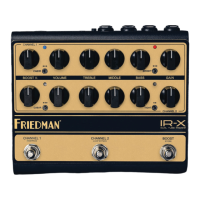3
11. Damage Requiring Service
– The Pre-Amp should be serviced by qualied service personnel when:
A. The power-supply cord or the plug has been damaged; or
B. Objects have fallen, or liquid has been spilled into the Pre-Amp; or
C. The Pre-Amp has been exposed to rain; or
D. The Pre-Amp does not appear to operate normally or exhibits
a marked change in performance; or
E. The Pre-Amp has been dropped, or the enclosure damaged.
F. The Pre-Amp needs tube replacement
12. Servicing
– The user should not attempt any service to the Pre-Amp beyond
that described in the operating instructions. All other servicing
should be referred to qualied service personnel.
13. Ventilation
– Slots and openings in the cabinet are provided for ventilation and
to ensure reliable operation of the product and to protect it from
overheating, and these openings must not be blocked or covered.
14. Replacement Parts
– When replacement parts are required, be sure the service
technician has used replacement parts specied by the
manufacturer or have the same characteristics as the original part.
Unauthorized substitutions may result in re, electric shock, or
other hazards.
15. Safety Check
– Upon completion of any service or repairs to this product, ask
the service technician to perform safety checks to determine that
the product is in proper operating condition.
NOTE: This equipment has been tested and found to comply with the
limits for a Class B digital device, pursuant to part 15 of the FCC Rules.
These limits are designed to provide reasonable protection against
harmful interference in a residential installation. This equipment gener-
ates, uses and can radiate radio frequency energy and, if not installed
and used in accordance with the instructions, may cause harmful inter-
ference to radio communications. However, there is no guarantee that
interference will not occur in a particular installation. If this equipment
does cause harmful interference to radio or television reception, which
can be determined by turning the equipment off and on, the user is
encouraged to try to correct the interference by one or more of the
following measures:
- Reorient or relocate the receiving antenna.
- Increase the separation between the equipment and receiver.
- Connect the equipment into an outlet on a circuit different from that
to which the receiver is connected.
- Consult the dealer or an experienced radio/ TV technician for help.
Changes or modications not expressly approved by the party
responsible for compliance could void the user’s authority to
operate the equipment.
This device complies with part 15 of the FCC Rules. Operation is
subject to the following two conditions: (1) This device may not cause
harmful interference, and (2) this device must accept any interference
received, including interference that may cause undesired operation.

